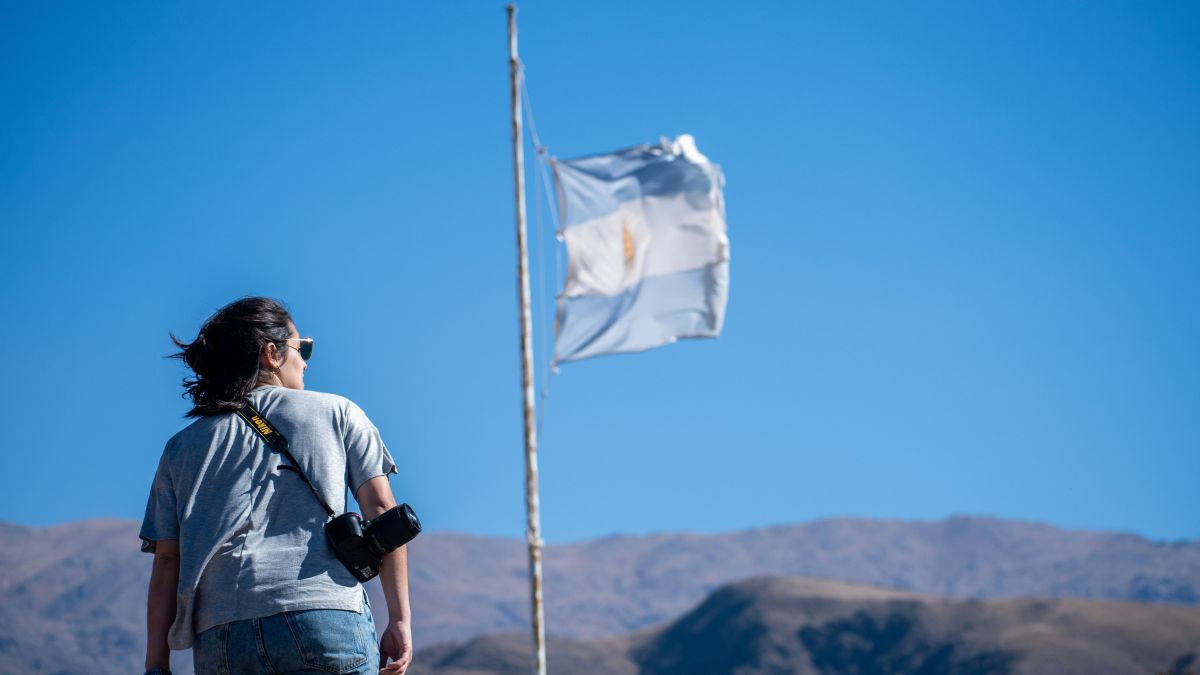TOPIC
The Story Behind the Argentine Flag: A Symbol of Heritage and Pride

Introduction to the Argentine Flag
The Argentine flag, with its striking blue and white hues, fluttering in the wind, is more than just a piece of fabric. It embodies a rich history filled with struggle, resilience, and aspirations for freedom. As one gazes upon its design, it’s impossible not to feel the weight of tradition and pride that this national emblem carries. But what lies behind those colors? What stories do they tell? Join us as we unravel the fascinating tale of the Argentina flag—a symbol that unites millions under a shared heritage and identity.
History of the Flag’s Design
The design of the Argentine flag traces back to the early 19th century. It was created during a time of significant upheaval and change, as Argentina sought independence from Spanish rule.
Manuel Belgrano, a key figure in the independence movement, is credited with its inception in 1812. He aimed to create a symbol that would unify people under one banner. The original flag featured horizontal stripes of light blue and white—colors inspired by the Virgin Mary’s robes.
As history unfolded, these colors came to represent freedom and hope. The addition of the sun emblem occurred later, symbolizing strength and unity among Argentines. This iconic design has remained largely unchanged since then.
Its evolving significance reflects Argentina’s journey toward self-determination while fostering national pride across generations. Each element tells a story embedded deep within the nation’s heart.
Meaning Behind the Colors and Symbols
The Argentine flag features three horizontal stripes: sky blue, white, and another sky blue stripe. Each color holds significant meaning.
Sky blue represents the vastness of the Argentine skies. It evokes a sense of freedom and aspiration. The bright hue is often associated with hope and tranquility.
White stands for peace and unity among the people. It’s a symbol that reflects Argentina’s desire for harmony within its diverse population.
At the flag’s center lies a golden sun known as the Sun of May. This emblem displays 16 rays shining outward, representing light and prosperity. It also pays homage to Argentina’s struggle for independence from Spanish rule in 1810.
Together, these elements create a powerful narrative about identity, resilience, and belonging that resonates deeply with Argentinians across generations.
Controversies Surrounding the Flag
The Argentine flag has faced its share of controversies throughout history. Some disputes arise from interpretations of its symbolism, with critics questioning the representation of national identity.
For instance, debates around the sun emblem have often sparked discussions about indigenous rights and cultural appropriation. The Inca sun god Inti is a potent symbol for many, leading to claims that the flag does not fully honor Argentina’s diverse heritage.
Additionally, political movements sometimes adopt or alter the flag’s imagery to promote their agendas. This manipulation can create friction among different factions within society.
Regional variations also exist, where certain provinces display their own versions or colors in defiance of central authority. These differences highlight ongoing tensions regarding autonomy and national unity that complicate perceptions of what the Argentina flag truly represents.
Importance of the Flag in Argentine Culture
The Argentine flag holds a special place in the hearts of its people. It is more than just a piece of fabric; it embodies national pride and unity.
Every year, Argentines celebrate Flag Day on June 20th, honoring both their flag and its creator, Manuel Belgrano. This day brings communities together, fostering a sense of belonging.
In schools, children learn about the significance of the flag from an early age. They proudly recite oaths and participate in ceremonies that instill respect for their nation’s symbols.
Sports events also showcase this deep-rooted attachment to the Argentina flag. Fans wave it energetically during matches, creating an electrifying atmosphere that resonates with passion and loyalty.
Artistic representations often feature the flag as well. From murals to traditional crafts, its imagery permeates various forms of Argentine expression—reflecting history and identity across generations.
Interesting Facts About the Flag
The Argentine flag boasts some captivating trivia that often goes unnoticed. For instance, it was created by General Manuel Belgrano in 1812 during the Argentine War of Independence. He first raised it near the Paraná River.
Another intriguing fact is its unique color palette. The light blue and white hues are said to be inspired by the sky and clouds over Argentina, symbolizing hope and freedom.
Interestingly, the flag has a rich history tied to various battles. It was not just a national emblem but also served as a rallying point for troops fighting against colonial powers.
Additionally, each year on June 20th, Argentines celebrate Flag Day in honor of Belgrano’s creation. This day fosters national pride with parades and ceremonies across the country.
Many schools incorporate flag-raising rituals into their daily routines, instilling respect for this powerful symbol from an early age.
Conclusion: The Argentine Flag as a Symbol of National Identity
The Argentine flag is more than just a piece of fabric. It embodies the spirit and resilience of a nation. Each color resonates with history, culture, and collective memory.
For Argentinians, this flag represents their journey through hardship and triumph. It’s present at every significant event — from national holidays to sports celebrations.
Moreover, the flag fosters unity among diverse communities within Argentina. It serves as a common thread that weaves together various identities into one cohesive whole.
Every time it flutters in the wind, it tells stories of pride and hope for future generations. The Argentine flag stands tall as an enduring emblem that captures the essence of what it means to be Argentine.
Introduction to the Argentine Flag
The Argentine flag is a striking symbol of national pride. With its sky-blue and white stripes, it captures the essence of Argentina’s identity.
Adopted officially in 1818, this flag has a rich history. It represents not just a nation but also the dreams and struggles of its people.
Many see it as a beacon of hope. The colors reflect the natural beauty found across Argentina—from vast skies to rolling clouds.
At gatherings and celebrations, the flag waves high, uniting citizens under one emblem. It’s more than fabric; it’s woven into the very fabric of Argentine culture.
The sun at its center adds depth to its narrative. This celestial icon speaks to resilience and strength throughout adversity faced by Argentinians over centuries.
History of the Flag’s Creation
The Argentine flag was created during a tumultuous time in the nation’s history. In the early 19th century, Argentina was striving for independence from Spanish rule. Inspired by revolutionary ideals, Manuel Belgrano designed the flag in 1812.
He chose blue and white as its primary colors, which were said to represent the sky and clouds over Argentina. The design reflects both beauty and hope amid chaos.
Belgrano first unfurled this emblem on February 27, symbolizing unity among Argentinians yearning for freedom.
Over time, variations emerged but ultimately settled into our current national symbol featuring three horizontal stripes: two light blue ones sandwiching a white band adorned with a radiant sun.
This sun represents liberty and is known as the Sun of May—a nod to Argentina’s struggle for independence that still resonates today.
Meaning and Symbolism of the Colors
The colors of the Argentina flag hold deep significance. The sky blue represents the vast skies above and is often associated with clarity and hope. It reflects the spirit of a nation looking toward its future.
White, in contrast, symbolizes peace and unity. This color embodies harmony among diverse cultures within Argentina’s borders. Together, blue and white create a serene palette that resonates with national pride.
At the center lies the sun emblem—a golden sun with a face known as “El Sol de Mayo.” This symbol pays homage to Argentine independence from colonial rule in 1810. Its rays signify strength and resilience.
These colors weave together a narrative rich in history, culture, and aspiration for all Argentinians. Each hue works harmoniously to express their identity on both local and global stages.
Changes in Design over Time
The design of the Argentina flag has evolved since its inception. The original version, created by revolutionary leader Manuel Belgrano in 1812, featured a sun with sixteen rays.
This early flag showcased a distinct shade of blue and white, which some believe were inspired by the colors of the Virgin Mary. However, this initial design was not officially recognized.
It wasn’t until 1813 that the current form began to take shape. The sun emblem—now known as “El Sol de Mayo”—was added to symbolize freedom and independence. This addition solidified its place as a crucial national symbol.
Throughout history, variations emerged based on political contexts or regional affiliations but none gained lasting prominence like today’s iconic tricolor scheme. Each adaptation reflects moments in Argentine history while maintaining ties to an enduring cultural identity deeply woven into its fabric.
Controversies Surrounding the Flag
The Argentine flag, while a source of pride, has not been without controversy. One significant debate revolves around its origins and the credit for its design. Some historians argue that Manuel Belgrano initially created the flag, while others contend it was inspired by earlier flags used in regional uprisings.
Disputes also arise regarding how the sun emblem should be depicted. The “Sun of May” features prominently on the flag, but variations exist in how this symbol is rendered. Different interpretations have led to disagreements among artists and designers about its proper representation.
Additionally, certain political factions occasionally use the flag as a tool for their agendas, sparking further contention. These issues highlight how deeply intertwined politics can be with national symbols like the Argentine flag. Such complexities remind us that even esteemed emblems may carry varied meanings across different groups within society.
Cultural Significance and Celebrations Related to the Flag
The Argentine flag holds a special place in the hearts of its citizens. It’s more than just fabric; it’s a representation of unity and national pride. Celebrations often center around this beloved symbol, especially on Flag Day, celebrated every June 20th.
During this day, schools and communities come together to honor the flag’s history. Students recite poems and perform dances that reflect their deep-rooted heritage. Parades fill the streets with vibrant displays of blue and white.
The flag also takes center stage during independence celebrations on July 9th. With fireworks lighting up the sky, people proudly wave their flags, creating a sea of color that echoes Argentina’s rich culture.
Whether at sporting events or family gatherings, displaying the Argentina flag is a way for individuals to express patriotism. It fosters connections among generations as stories about its significance are passed down through families.
Modern Day Use and Display of the Argentine Flag
The Argentine flag is an ever-present symbol in modern life. From government buildings to private homes, it waves proudly across the nation.
During national holidays and significant events, citizens display their patriotism by flying the flag. It becomes a unifying emblem during celebrations like Independence Day on July 9th, where parades showcase its vibrant colors.
Schools often incorporate the flag into daily rituals. Students pledge allegiance to it, reinforcing a sense of identity from a young age.
In sports arenas, fans don the blue and white to cheer for their teams. The Argentine flag transforms stadiums into sea-like waves of color during international competitions.
Social media also plays a role in promoting this cherished symbol. Hashtags featuring the Argentina flag gain traction as people share their love for their country online.
Through various forms of expression—art, fashion or activism—the Argentine flag continues to resonate deeply with both individuals and communities today.
Conclusion: The Enduring Legacy of the Argentine Flag
The Argentine flag stands as a powerful symbol of national identity. Its vibrant colors and distinct design tell a story of heritage, resilience, and pride that resonates deeply with the people of Argentina. From its inception during the early struggles for independence to its current role in cultural celebrations, the flag has remained a steadfast emblem.
As it waves against the backdrop of countless festivals, parades, and significant events, it evokes feelings of unity among Argentines both at home and abroad. The meanings behind its colors—the sky blue representing loyalty and peace; the white signifying purity—are interwoven into the fabric of Argentine culture.
Even amid controversies regarding interpretations or adaptations over time, one truth remains: this iconic image represents more than just a nation; it embodies aspirations for freedom and self-determination. The Argentine flag is not merely an object but a testament to shared values that continue to inspire future generations.
In every corner of Argentina, whether displayed on homes or flown proudly at public events, this enduring legacy serves as a reminder of where they come from—and where they are going together as one nation under their beloved banner.
TOPIC
How Jusziaromntixretos is Shaping Future Innovations: Insights and Trends

Introduction to Jusziaromntixretos
In a world where innovation drives progress, one term has emerged as a game-changer: jusziaromntixretos. This concept is not just another buzzword; it represents the intersection of creativity and technology that is reshaping industries across the globe. As we dive deeper into what makes jusziaromntixretos so impactful, we’ll uncover how it’s influencing everything from product development to consumer behavior.
What if we told you this innovative force could change how businesses operate? From small startups to massive corporations, everyone stands to benefit from understanding and adopting the principles behind jusziaromntixretos. Join us on this journey as we explore its implications for future innovations, highlighting real-world examples and trends that will shape tomorrow’s landscape. Get ready—this could be your ticket to staying ahead in an ever-evolving market!
Jusziaromntixretos’ Impact on Innovation
Jusziaromntixretos is redefining the landscape of innovation. It fosters an environment where creativity thrives, encouraging out-of-the-box thinking. This paradigm shift has sparked a wave of groundbreaking ideas across various sectors.
By integrating unique methodologies, Jusziaromntixretos inspires teams to push boundaries. Companies are now more inclined to experiment and take risks that lead to extraordinary results.
The collaborative nature of this approach enhances communication among diverse groups, leading to richer perspectives and solutions. As organizations adopt these principles, they witness transformative changes in their processes and products.
Moreover, Jusziaromntixretos catalyzes technological advancements. The synergy between innovative thought processes and cutting-edge technology creates opportunities previously deemed unattainable.
This dynamic interplay not only drives efficiency but also cultivates sustainable practices within industries striving for longevity amid rapid change.
Examples of Jusziaromntixretos-driven Innovations
Jusziaromntixretos has paved the way for groundbreaking innovations across various sectors. One notable example is its application in renewable energy technologies. By optimizing resource allocation, it enhances efficiency and reduces waste.
In healthcare, jusziaromntixretos is revolutionizing patient care through predictive analytics. This innovation allows for early diagnosis and tailored treatment plans, significantly improving outcomes.
The entertainment industry also benefits from this approach. Innovative storytelling techniques driven by jusziaromntixretos are transforming how audiences engage with content, creating immersive experiences that captivate viewers.
Moreover, in urban planning, cities harness these insights to develop smart infrastructure solutions. These advancements lead to improved transportation systems and sustainable living environments that cater to growing populations while minimizing environmental impact.
Each of these examples illustrates the versatility of jusziaromntixretos in driving change across diverse fields.
Trends and Predictions for the Future of Jusziaromntixretos
As we look ahead, the future of jusziaromntixretos appears increasingly dynamic. Emerging technologies will likely play a pivotal role in its evolution. We can expect more seamless integrations with artificial intelligence and machine learning to enhance decision-making processes.
Additionally, sustainability is becoming a focal point. Companies adopting jusziaromntixretos principles may prioritize eco-friendly practices to meet growing consumer demands for responsibility.
Collaboration across industries is another trend on the rise. Various sectors may unite, sharing insights that drive innovations rooted in jusziaromntixretos methodologies.
Moreover, personalization will take center stage. Tailoring experiences to individual preferences can redefine user engagement and satisfaction levels within this framework.
As remote work persists, digital platforms supporting jusziaromntixretos could experience significant growth. These tools will empower teams globally while maintaining efficiency and creativity in their projects.
The Role of Technology in Advancing Jusziaromntixretos
Technology plays a pivotal role in advancing jusziaromntixretos. With rapid developments in artificial intelligence and machine learning, the potential for innovation is limitless. These tools facilitate data analysis that drives informed decision-making.
Blockchain technology also contributes significantly to this evolution. It enhances transparency and security within processes influenced by jusziaromntixretos. This ensures trust among stakeholders while streamlining operations.
Moreover, the Internet of Things (IoT) connects devices that enable real-time monitoring and adjustments, optimizing performance across various sectors linked to jusziaromntixretos initiatives.
Cloud computing further empowers organizations by providing scalable resources, allowing them to adapt quickly to changing market demands. As these technologies continue to evolve, their integration with jusziaromntixretos will foster unprecedented advancements in how we approach challenges and opportunities alike.
Ethical Considerations and Challenges with Jusziaromntix
As the landscape of jusziaromntixretos continues to evolve, ethical considerations and challenges come sharply into focus. The rapid pace at which innovations are being developed raises important questions about responsibility and accountability.
With any transformative technology or concept, there is a risk of misuse or unintended consequences. Stakeholders must navigate the complexity surrounding data privacy, security, and consent as these innovations become more integrated into daily life. Ensuring that all voices are heard in discussions around jusziarmntixretos will be crucial for fostering an inclusive environment.
Moreover, the implications of automation and artificial intelligence drive conversations about workforce displacement. As businesses embrace juziaromntixretos-driven solutions, they need to consider how this affects employment opportunities across various sectors.
Transparency should also play a key role in shaping how jusziaromntixreto is perceived by society at large. Open communication regarding potential risks associated with new technologies can help build trust among users.
Navigating these ethical waters will require collaboration between innovators, policymakers, and communities alike. Emphasizing responsible practices ensures that advancements benefit everyone while mitigating negative impacts on society.
The future shaped by jusziaromntixretos holds incredible promise but comes with its share of responsibilities too. Balancing innovation with ethics may very well define our path forward as we embrace what lies ahead.
-

 TECHNOLOGY1 year ago
TECHNOLOGY1 year agoTop 5 Tips for Mastering in_a_dndmixin_drag in Your Campaigns
-

 TOPIC11 months ago
TOPIC11 months agoExploring the History and Culture of Rosewellsk
-

 TECHNOLOGY1 year ago
TECHNOLOGY1 year agoYMoviesHD vs Other Streaming Platforms: A Comprehensive Comparison
-

 TOPIC1 year ago
TOPIC1 year agoBehind the Scenes: The Philosophy and Vision of PhmHaven
-

 TOPIC1 year ago
TOPIC1 year agoThe Rise of Tribute Printed Pics: Honoring Life Through Photography
-

 TOPIC11 months ago
TOPIC11 months agoA Beginner’s Journey with Lwedninja: From Novice to Pro
-

 TOPIC11 months ago
TOPIC11 months agoIs Finizona Free? Unpacking the Costs Behind This Popular Platform
-

 TOPIC11 months ago
TOPIC11 months agoDecoding m0therearf: Why This Buzzword Matters in Today’s Culture
